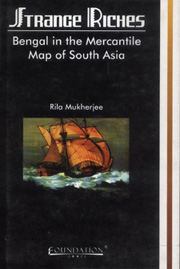Book contents
- Frontmatter
- Contents
- Epigraph
- Preface
- Acknowledgments
- Abbreviations
- Map 1 Places mentioned in Bengal and Arakan: 5th to 13th centuries
- Map 2 Land and sea routes of the Eastern Indian Ocean: 13th to 15th centuries
- 1 Introduction
- 2 Conceptual Formulations
- 3 Key Issues: Bengal
- 4 Introducing Bengal
- 5 The Debated Century
- 6 Networks and States in South Asia
- 7 Unities of Time and Space in Bengal
- 8 Bengal in the Indian Ocean Centred World Economy
- 9 Conclusion
- Bibliography
- Index
6 - Networks and States in South Asia
Published online by Cambridge University Press: 26 October 2011
- Frontmatter
- Contents
- Epigraph
- Preface
- Acknowledgments
- Abbreviations
- Map 1 Places mentioned in Bengal and Arakan: 5th to 13th centuries
- Map 2 Land and sea routes of the Eastern Indian Ocean: 13th to 15th centuries
- 1 Introduction
- 2 Conceptual Formulations
- 3 Key Issues: Bengal
- 4 Introducing Bengal
- 5 The Debated Century
- 6 Networks and States in South Asia
- 7 Unities of Time and Space in Bengal
- 8 Bengal in the Indian Ocean Centred World Economy
- 9 Conclusion
- Bibliography
- Index
Summary
Bengal in the Islamic Network and the Rise of the Early Modern States System
Chingiz Khan sent a great number of rareties and offerings with us for presentation to Sultan Muhammad, Khwarazm Shah, and said–“Say ye unto Khwarazm Shah, I am the sovereign of the sunrise and thou the sovereign of the sunset'’, on the occasion of his march from China (Tibet) towards Persia, in Minhaj-ud-Din Abu Umar-I-Usman's Tabakat-I-Nasiri: A General History of the Muhammadan Dynasties of Asia from 810 AD to 1260 AD and the Irruption of the Infidel Mughals into Islam (Tr). Raverty, H.G.I881, Reprint, New Delhi, Oriental Books Corporation, 1970: 966.
If structural changes in the Islamic and Christian worlds signalled the ending of the ancient world by the early medieval period in South Asia the Mongols too paved the way for the ending of the ancient world in Asia in the thirteenth century. Paradoxically this was also the century when Islam formally entered Bengal and the first ever Islamic state was established there.
What was the nature of this new Islamic state? Do we merely designate it as a ‘conquest’ state with a dynamism directed towards events within South Asia or do we seek to integrate the inherent dynamism of this new state within the larger framework of Islamic states that stretched across the civilised world in the thirteenth century? In other words can we establish a typology for this new state form that arose in South Asia and thereby move away from the ‘Islamic’ label?
- Type
- Chapter
- Information
- Strange RichesBengal in the Mercantile Map of South Asia, pp. 291 - 318Publisher: Foundation BooksPrint publication year: 2006



